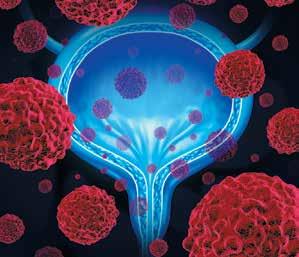
1 minute read
Spotlight on bladder and urothelian cancer
What is bladder cancer?
The bladder is an organ in your pelvis that is part of the urinary system. It works with the kidneys to eliminate the body of waste products from the blood. The bladder has muscular walls that stretch to store urine until it is ready to empty. Urine is liquid waste made by the two kidneys and then carried to the bladder through two tubes called ureters. When you urinate, the muscles in the bladder contract, and urine is forced out of the bladder through a tube called the urethra. Your bladder can hold about 500ml of urine, but you usually feel the need to urinate when it’s holding around 300ml. And just like the urethra, ureters, prostate and renal pelvis, the bladder is lined by a layer of tissue called the urothelium.
Bladder cancer develops when abnormal cells in the lining of the bladder grow and divide in an uncontrolled manner. Cancer that begins in the urothelium of the bladder is much more common than cancer that begins in the urothelium of the urethra, ureters, prostate, or renal pelvis.
Types of bladder cancer
Bladder cancer takes different forms:
• urothelial carcinoma, formally known as transitional cell carcinoma, is the most common form of bladder cancer (80-90%) and starts in the urothelial cells in the bladder wall’s innermost layer
• squamous cell carcinoma begins in the thin, flat cells that line the bladder
• adenocarcinoma is a rare form which starts in mucusproducing cells in the bladder.
If you develop bladder cancer in the lining of the bladder it is called superficial bladder cancer. But if the cancer cells spread to the muscle wall of the bladder, or even further to other organs or lymph nodes, it is called invasive bladder cancer.
Bladder cancer remains the only cancer with survival rates that have deteriorated over the past 30 years.
Bladder cancer was the 11th most commonly diagnosed cancer in Australia in 2020. In 2020, it is estimated 3098 cases of bladder cancer will be diagnosed in Australia (2389 males and 710 females). This is equivalent to an estimated incidence rate of 9.6 cases per 100,000 persons. In addition, it is estimated there will be 1016 deaths in Australia from bladder cancer but from 2012 – 2016 on average, 54.3% of people diagnosed with bladder cancer survived 5 years after diagnosis.*









